Bedaquiline-Loaded Solid Lipid Nanoparticles Drug Delivery in the Management of Non-Small-Cell Lung Cancer (NSCLC)
Abstract
1. Introduction
2. Results
2.1. Method Development for BQ Using UPLC-MS/MS
2.2. Accuracy
2.3. Precision
2.4. Limits of Quantitation and Limit of Detection
2.5. Choosing Excipients Based on Solubility Studies
2.6. Preparation of the SLNs and Suspension
2.7. Characterization of the SLNs and Suspension
2.7.1. Particle Size, Polydispersity Index, Zeta Potential and Structural Morphology
2.7.2. Entrapment Efficiency and Loading Capacity
2.8. Stability Studies of BQ-SLN3 and BQ-Suspension
2.8.1. Particle Size, Size Distribution, and Zeta Potential
2.8.2. Encapsulation Efficiency and Loading Capacity
2.9. In Vitro Gastrointestinal Stability
2.10. In Vitro Drug Release
2.11. Cell Culture and Cell Viability Study
2.12. Pharmacokinetic Study
2.13. Biodistribution Studies
2.14. Biochemical Parameters Determination
2.15. Pharmacodynamic Evaluation
3. Discussion
4. Materials and Methods
4.1. Materials
4.2. Methods
4.2.1. Method Development for BQ Using Ultra-Performance Liquid Chromatography Tandem Mass Spectrometry (UPLC-MS/MS)
4.2.2. Selection of Ingredients
Solubility Study
4.2.3. Preparation of the SLNs and Suspension
4.2.4. Characterization of the SLNs and Suspension
Particle Size, Polydispersity Index, Zeta Potential, and Structural Morphology
Encapsulation Efficiency (EE) and Drug Loading Capacity (LC)
4.2.5. Stability Studies of SLNs and Suspension
4.2.6. In Vitro Gastrointestinal Stability
4.2.7. In Vitro Drug Release
4.2.8. Studies of Cell Viability and Cell Culture
Cytotoxicity Studies
4.2.9. Animal Studies
Pharmacokinetic Study
Biodistribution Studies
Biochemical Measurements
Pharmacodynamic Evaluations
Data Analysis
5. Conclusions
Author Contributions
Funding
Institutional Review Board Statement
Informed Consent Statement
Data Availability Statement
Acknowledgments
Conflicts of Interest
References
- Kunda, N.K. Antimicrobial peptides as novel therapeutics for non-small cell lung cancer. Drug Discov. Today 2020, 25, 238–247. [Google Scholar] [CrossRef] [PubMed]
- Schabath, M.B.; Cote, M.L. Cancer Progress and Priorities: Lung Cancer. Cancer Epidemiol. Biomark. Prev. 2019, 28, 1563–1579. [Google Scholar] [CrossRef] [PubMed]
- Parvathaneni, V.; Kulkarni, N.S.; Muth, A.; Gupta, V. Drug repurposing: A promising tool to accelerate the drug discovery process. Drug Discov. Today 2019, 24, 2076–2085. [Google Scholar] [CrossRef] [PubMed]
- Yadav, V.; Talwar, P. Repositioning of fluoroquinolones from antibiotic to anticancer agents: An underestimated truth. Biomed. Pharmacother. 2019, 111, 934–946. [Google Scholar] [CrossRef]
- Stylianopoulos, T.; Soteriou, K.; Fukumura, D.; Jain, R.K. Cationic Nanoparticles Have Superior Transvascular Flux into Solid Tumors: Insights from a Mathematical Model. Ann. Biomed. Eng. 2013, 41, 68–77. [Google Scholar] [CrossRef]
- Wu, X.; Li, F.; Wang, X.; Li, C.; Meng, Q.; Wang, C.; Huang, J. Antibiotic bedaquiline effectively targets growth, survival and tumor angiogenesis of lung cancer through suppressing energy metabolism. Biochem. Biophys. Res. Commun. 2018, 495, 267–272. [Google Scholar] [CrossRef] [PubMed]
- Diplock, A.T.; Rice-Evans, A.C.; Burton, R.H. Is there a significant role for lipid peroxidation in the causation of malignancy and for antioxidants in cancer prevention. Cancer Res. 1994, 54, 19525–19565. [Google Scholar]
- Oshima, H.; Tademichi, M.; Sawa, T. Chemical basis of inflammation-induced carcinogenesis. Arch. Biochem. Biophys. 2003, 417, 3–11. [Google Scholar] [CrossRef]
- Halliwell, B. Free radicals, antioxidants, and human disease: Curiosity, cause, or consequence? Lancet 1994, 344, 721. [Google Scholar] [CrossRef]
- Mahapatra, S.K.; Das, S.; Dey, S.K.; Roy, S. Smoking induced oxidative stress in serum and neutrophil of the university students. Al Ameen J. Med. Sci. 2008, 1, 20–31. [Google Scholar]
- Ho, J.C.M.; Zheng, S.; Comhair, S.A.A.; Farver, C.; Erzurum, S.C. Differential expression of manganese superoxide dismutase and catalase in lung cancer. Cancer Res. 2001, 61, 8578–8585. [Google Scholar]
- Minchinton, A.I.; Tannock, I.F. Drug penetration in solid tumours. Nat. Rev. Cancer 2006, 6, 583–592. [Google Scholar] [CrossRef] [PubMed]
- Behbahani, E.S.; Ghaedi, M.; Abbaspour, M.; Rostamizadeh, K. Optimization and characterization of ultrasound assisted preparation of curcumin-loaded solid lipid nanoparticles: Application of central composite design, thermal analysis, and X-ray diffraction techniques. Ultrason. Sonochem. 2017, 38, 271–280. [Google Scholar] [CrossRef] [PubMed]
- Koroleva, M.; Portnaya, I.; Mischenko, E.; Abutbul-Ionita, I.; Kolik-Shmuel, L.; Danino, D. Solid lipid nanoparticles and nanoemulsions with solid shell: Physical and thermal stability. J. Colloid Interface Sci. 2022, 610, 61–69. [Google Scholar] [CrossRef] [PubMed]
- Madan, J.; Pandey, R.S.; Jain, V.; Jain, V.; Katare, O.P.; Chandra, R.; Katyal, A. Polyethylene)-glycol conjugated solid lipid nanoparticles of noscapine improve biological half-life, brain delivery and efficacy in glioblastoma cells. Nanomedicine 2013, 9, 492–503. [Google Scholar] [CrossRef]
- Tang, X.; Zhou, S.; Tao, X.; Wang, J.; Wang, F.; Liang, Y. Targeted delivery of docetaxel via Pi-Pi stacking stabilized dendritic polymeric micelles for enhanced therapy of liver cancer. Mater. Sci. Eng. C Mater. Biol. Appl. 2017, 75, 1042–1048. [Google Scholar] [CrossRef]
- Bhattacharyya, S.; Reddy, P. Effect of Surfactant on Azithromycin Dihydrate Loaded Stearic Acid Solid Lipid Nanoparticles. Turk. J. Pharm. Sci. 2019, 16, 425–431. [Google Scholar] [CrossRef]
- Wang, F.Z.; Zhang, M.W.; Zhang, D.S.; Huang, Y.; Chen, L.; Jiang, S.M.; Shi, K.; Li, R. Preparation, optimization, and characterization of chitosan-coated solid lipid nanoparticles for ocular drug delivery. J. Biomed. Res. 2018, 32, 411–423. [Google Scholar]
- Aliabadi, H.M.; Romanick, M.; Somayaji, V.; Mahdipoor, P.; Lavasanifar, A. Stability of compounded thioguanine oral suspensions. Am. J. Health Syst. Pharm. 2011, 68, 900–908. [Google Scholar] [CrossRef]
- Gidwani, B.; Vyas, A. Preparation, characterization, and optimization of altretamine-loaded solid lipid nanoparticles using Box-Behnken design and response surface methodology. Artif. Cells Nanomed. Biotechnol. 2016, 44, 571–580. [Google Scholar] [CrossRef]
- Zhang, J.; Liang, H.; Yao, H.; Qiu, Z.; Chen, X.; Hu, X.; Hu, J.; Zheng, G. The preparation, characterization of Lupeol PEGylated liposome and its functional evaluation in vitro as well as pharmacokinetics in rats. Drug Dev. Ind. Pharm. 2019, 45, 1052–1060. [Google Scholar] [CrossRef] [PubMed]
- Sarkar, S.; Yadav, P.; Trivedi, R.; Bansal, A.K.; Bhatnagar, D. Cadmium induced lipid peroxidation and the status of the antioxidant system in rat tissues. J. Trace Elem. Med. Biol. 1995, 9, 144–147. [Google Scholar] [CrossRef] [PubMed]
- Zhai, S.; Deng, X.; Zhang, C.; Zhou, Y.; Xie, H.; Jiang, Z.; Jia, L. A novel UPLC/MS/MS method for rapid determination of murrayone in rat plasma and its pharmacokinetics. J. Pharm. Biomed. Anal. 2020, 180, 113046. [Google Scholar] [CrossRef]
- Metcalfe, J.; Gerona, R.; Wen, A.; Bacchetti, P.; Gandhi, M. An LC-MS/MS-based method to analyze the anti-tuberculosis drug bedaquiline in hair. Int. J. Tuberc. Lung Dis. 2017, 21, 1069–1070. [Google Scholar] [CrossRef][Green Version]
- Huang, Z.; Wu, L.; Wang, W.; Wang, W.; Fu, F.; Zhang, X.; Huang, Y.; Pan, X.; Wu, C. Major difference in particle size, minor difference in release profile: A case study of solid lipid nanoparticles. Pharm. Dev. Technol. 2021, 26, 1110–1119. [Google Scholar] [CrossRef] [PubMed]
- Ban, C.; Jo, M.; Park, Y.H.; Kim, J.H.; Han, J.Y.; Lee, K.W.; Kweon, D.H.; Choi, Y.J. Enhancing the oral bioavailability of curcumin using solid lipid nanoparticles. Food Chem. 2020, 302, 125328. [Google Scholar] [CrossRef]
- Rasouliyan, F.; Eskandani, M.; Jaymand, M.; Akbari, N.S.; Farahzadi, R.; Vandghanooni, S.; Eskandani, M. Preparation, physicochemical characterization, and anti-proliferative properties of Lawsone-loaded solid lipid nanoparticles. Chem. Phys. Lipids 2021, 239, 105123. [Google Scholar] [CrossRef]
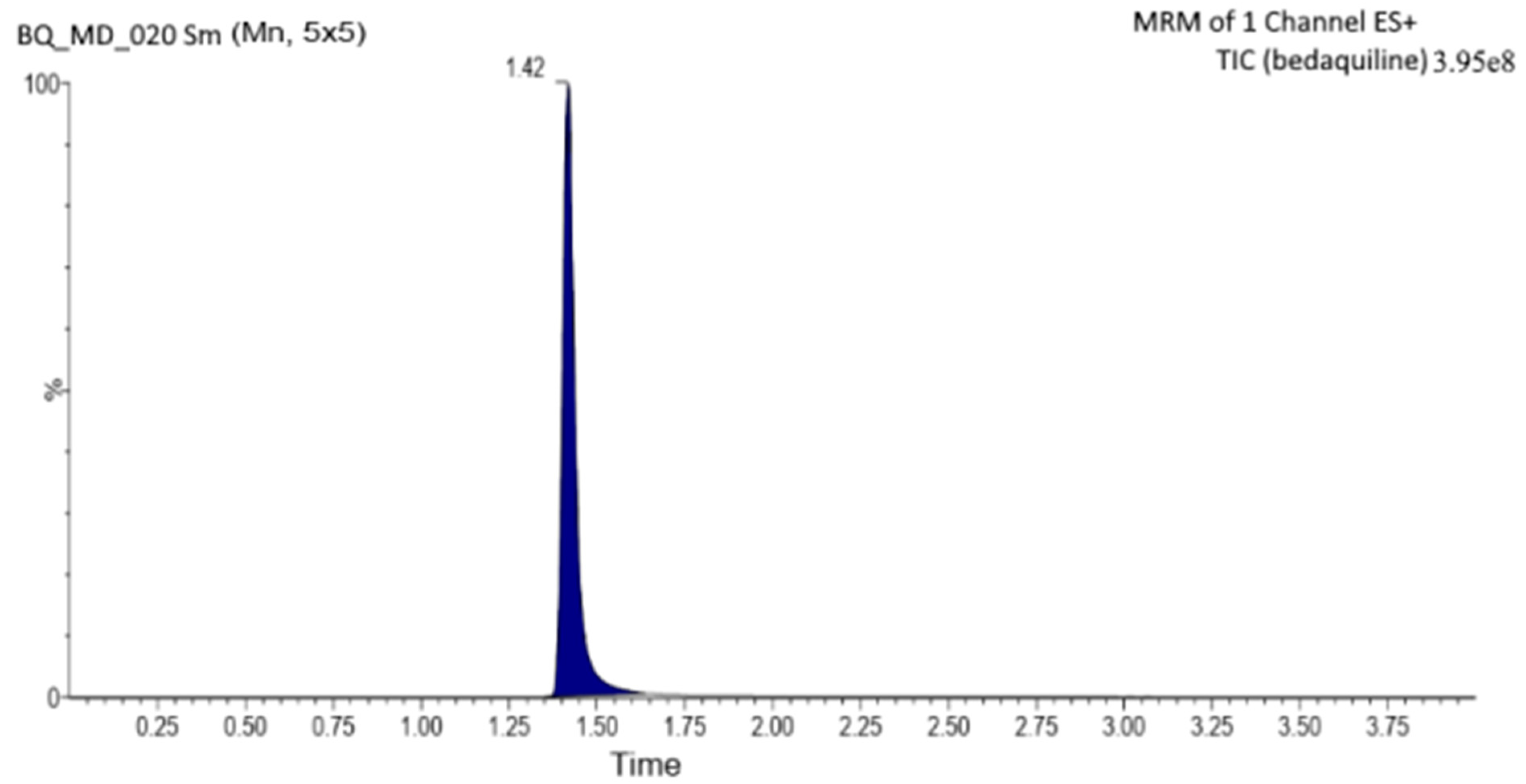
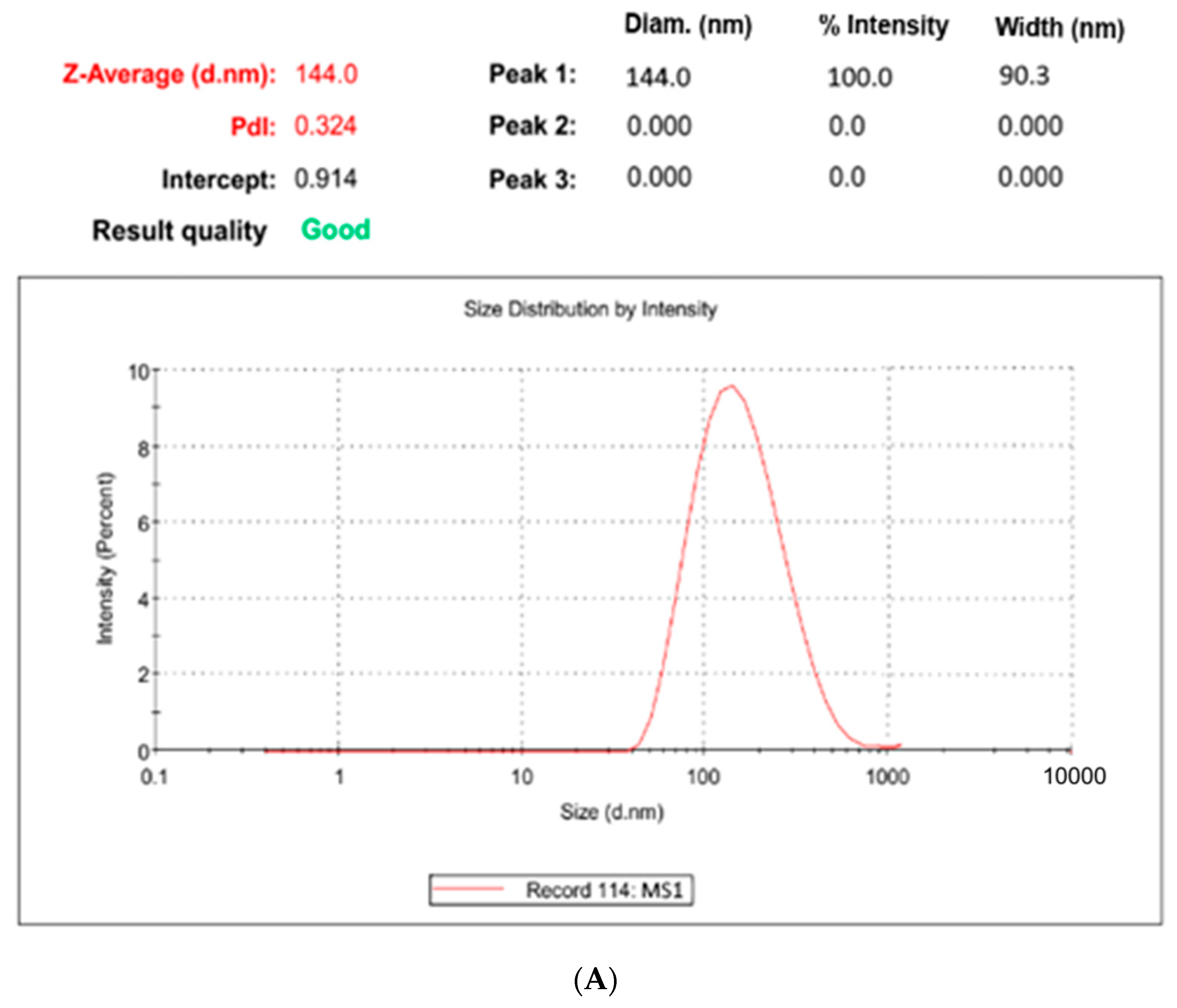
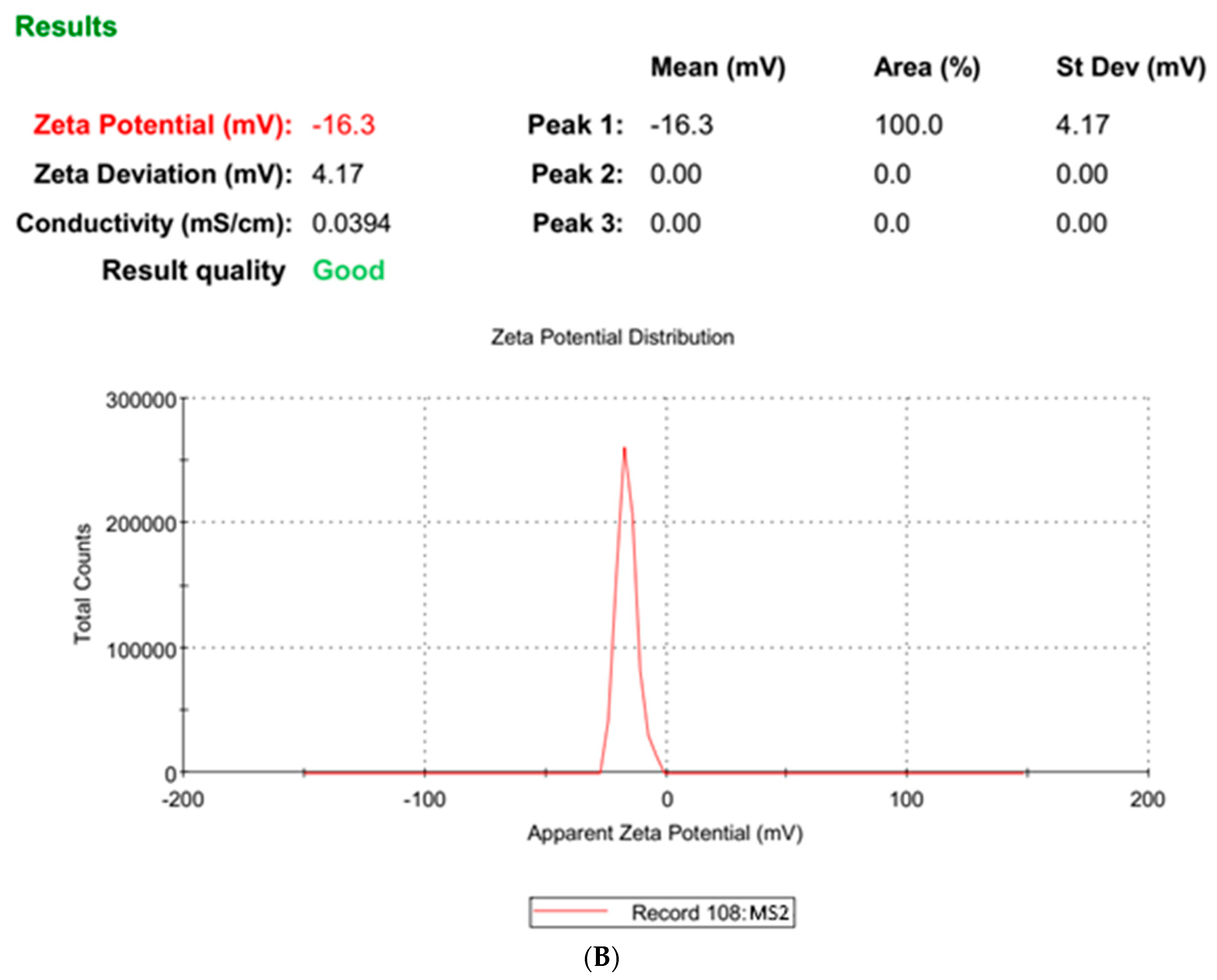
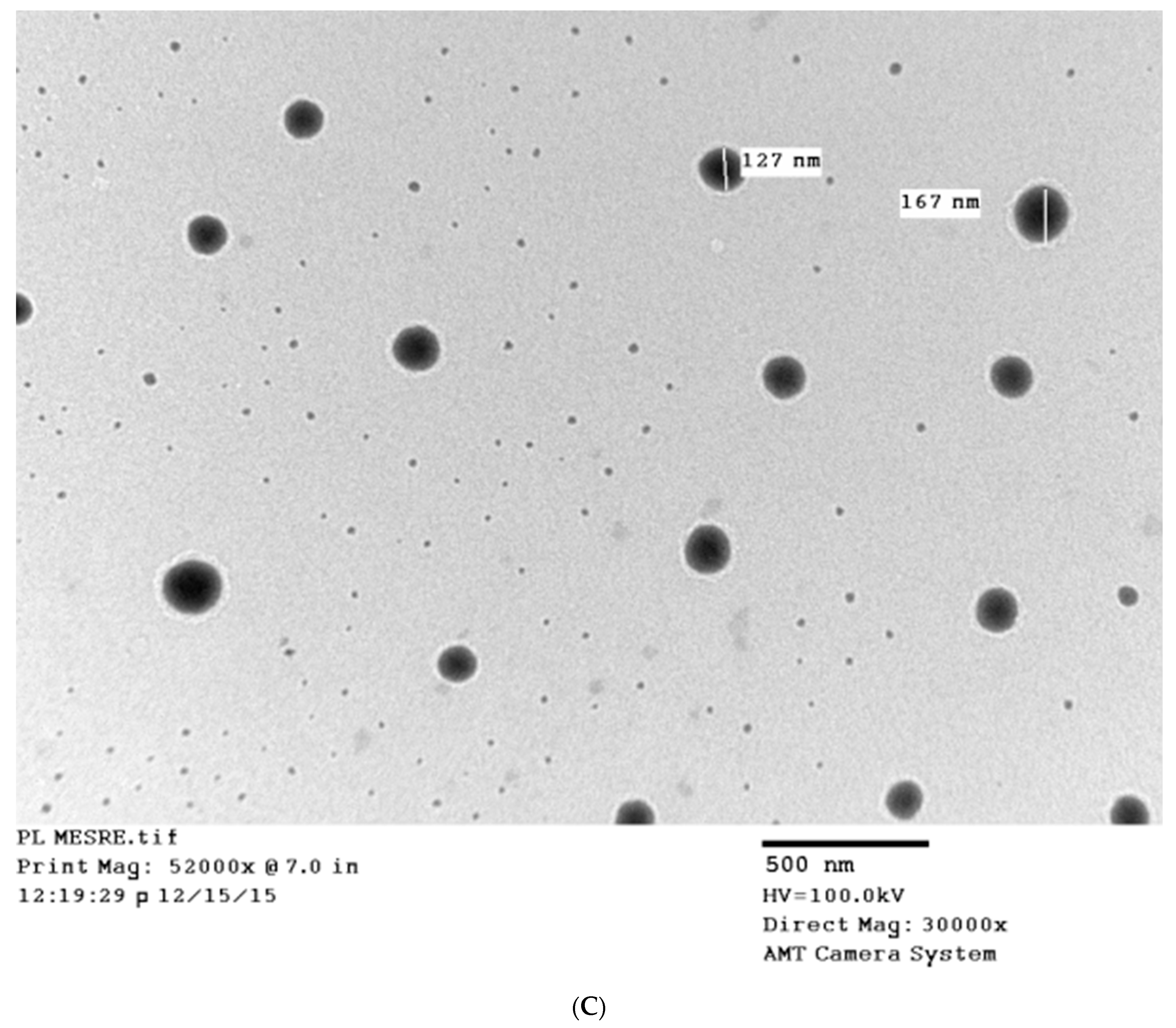
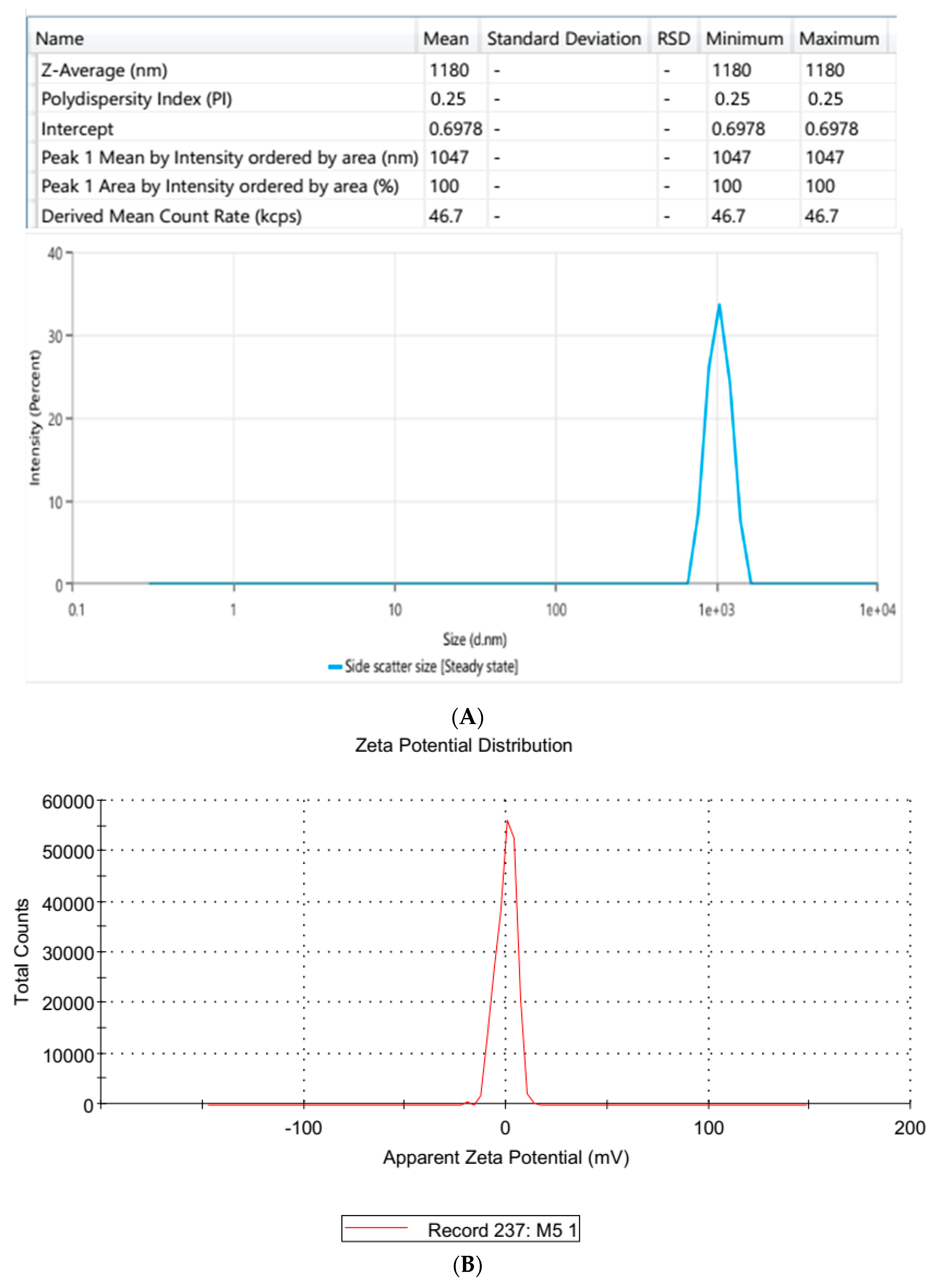
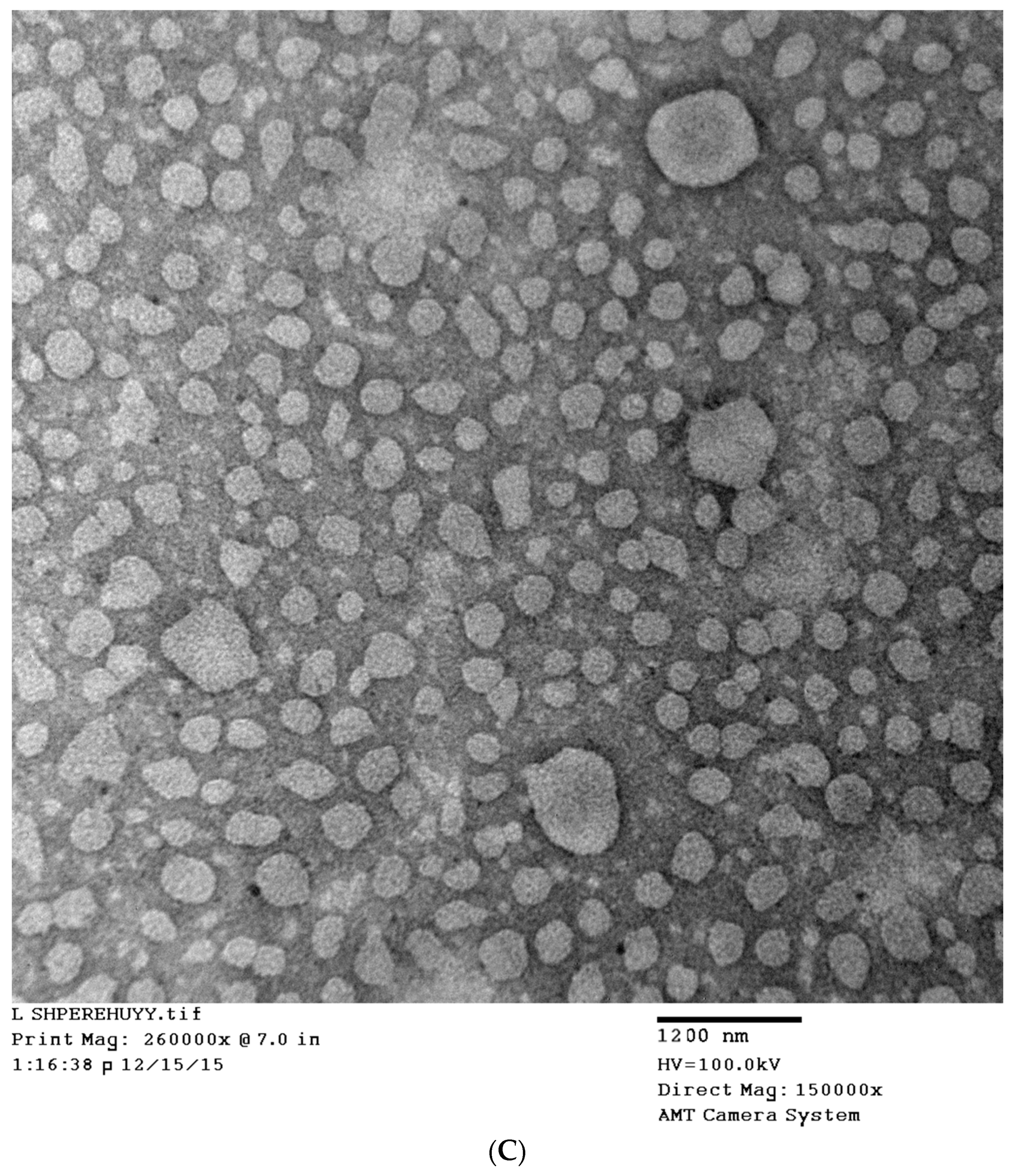
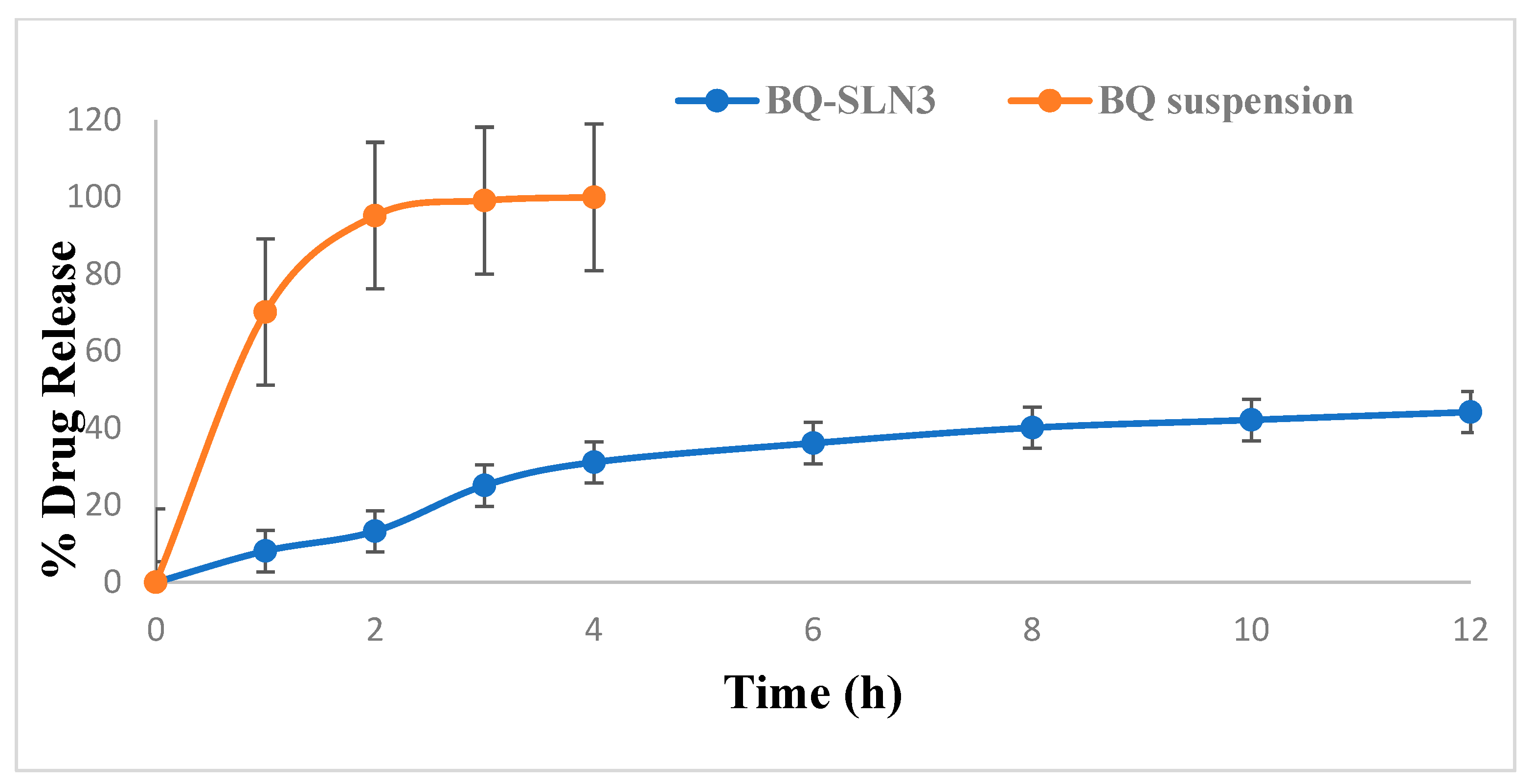
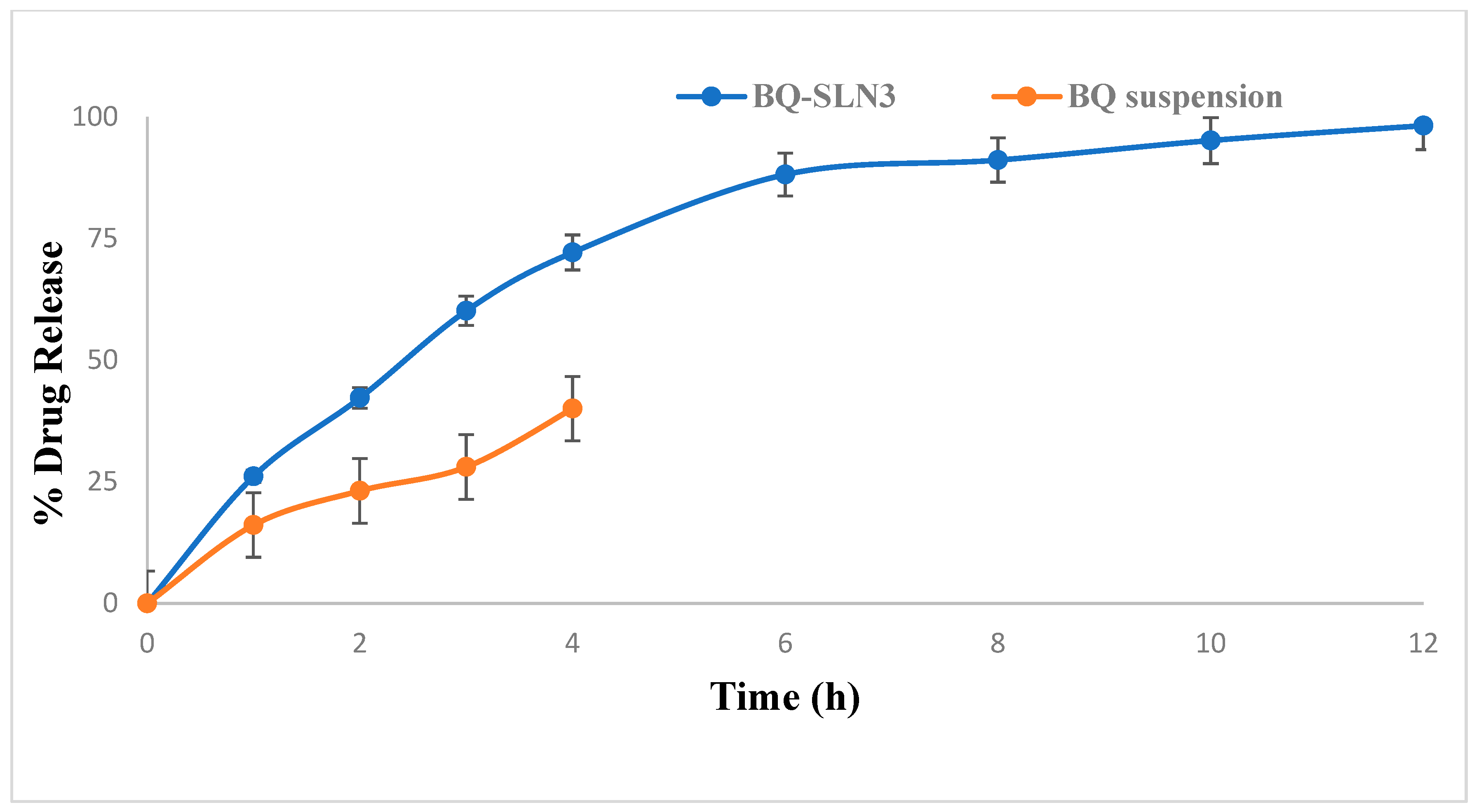
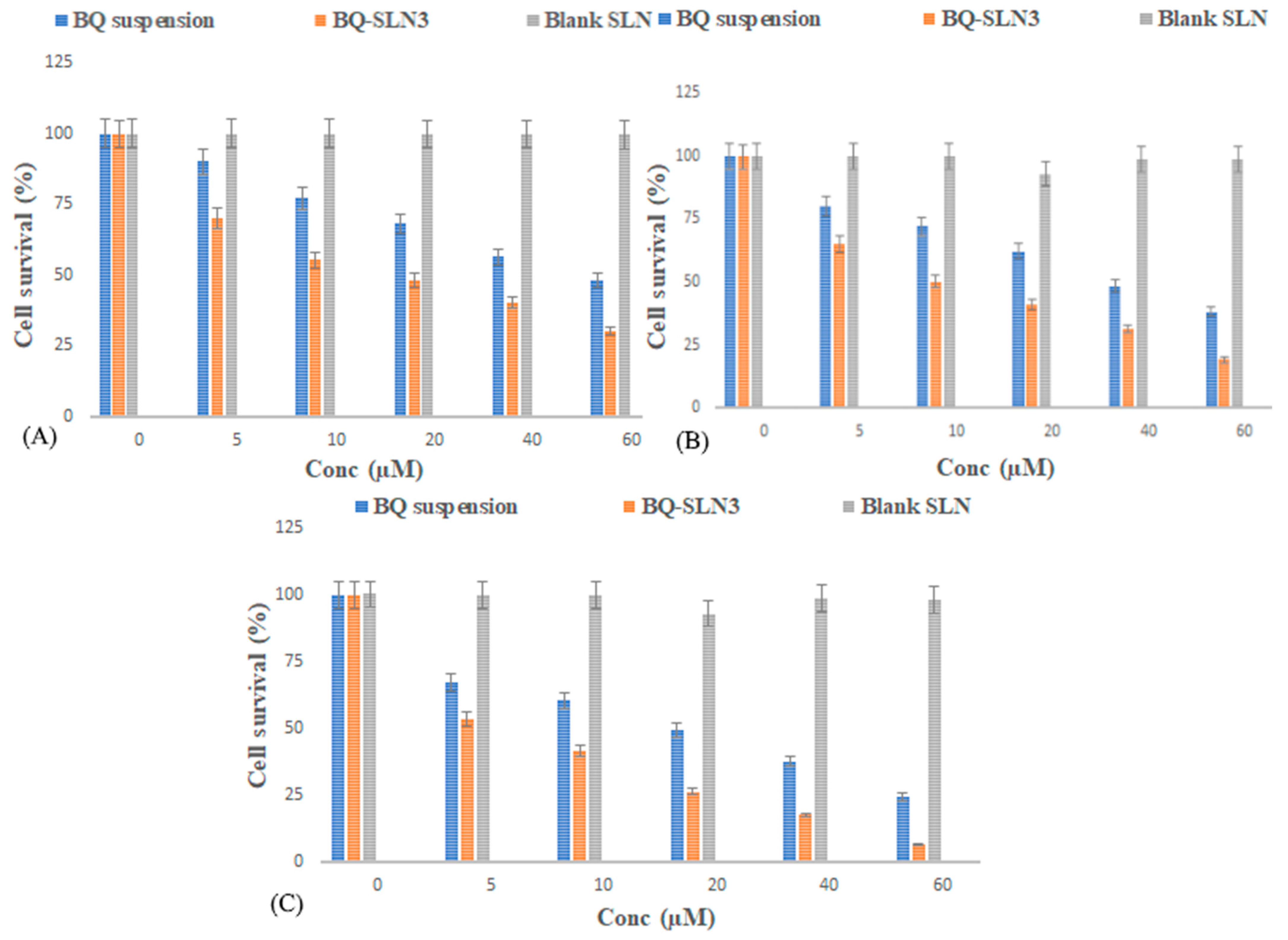
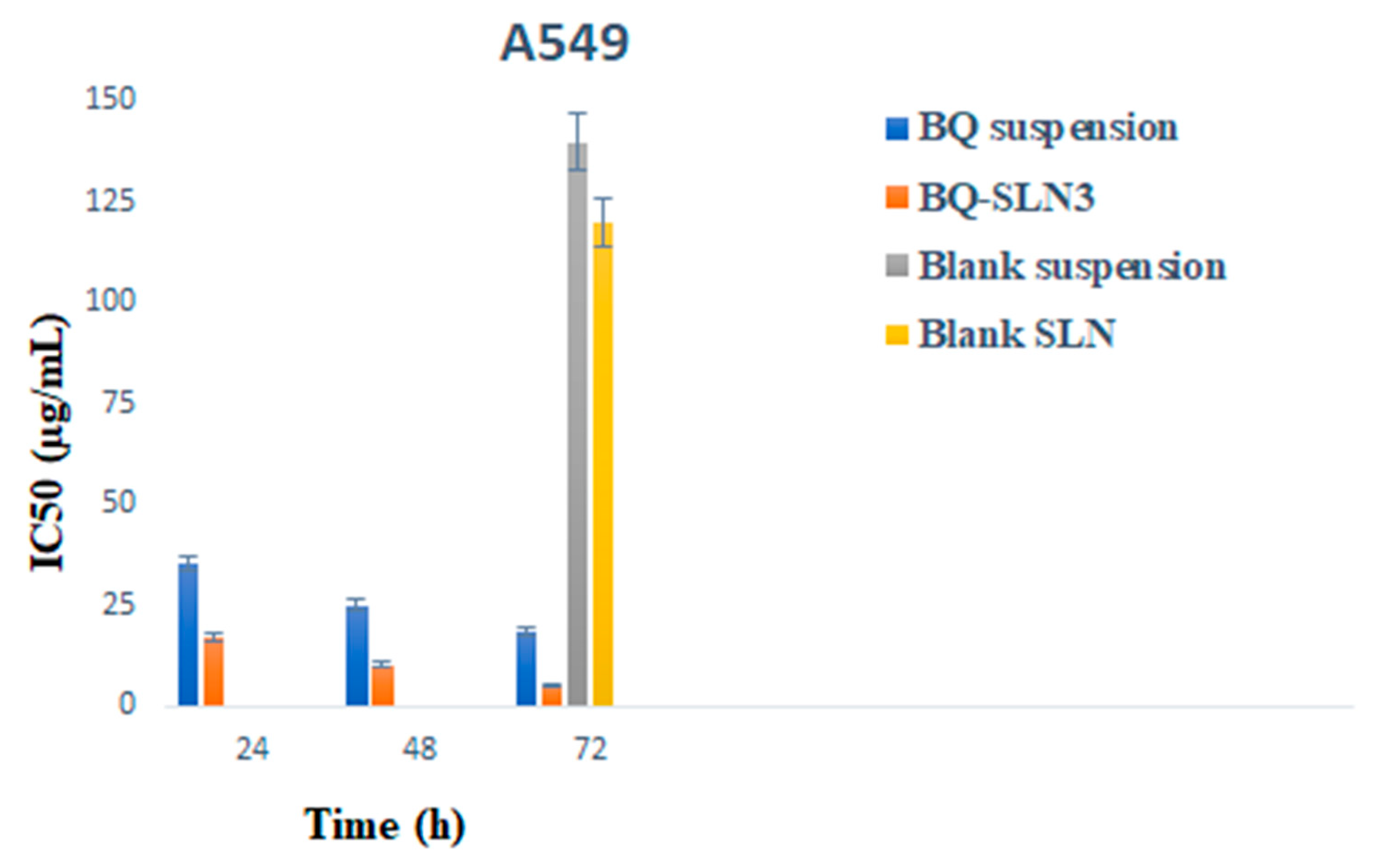
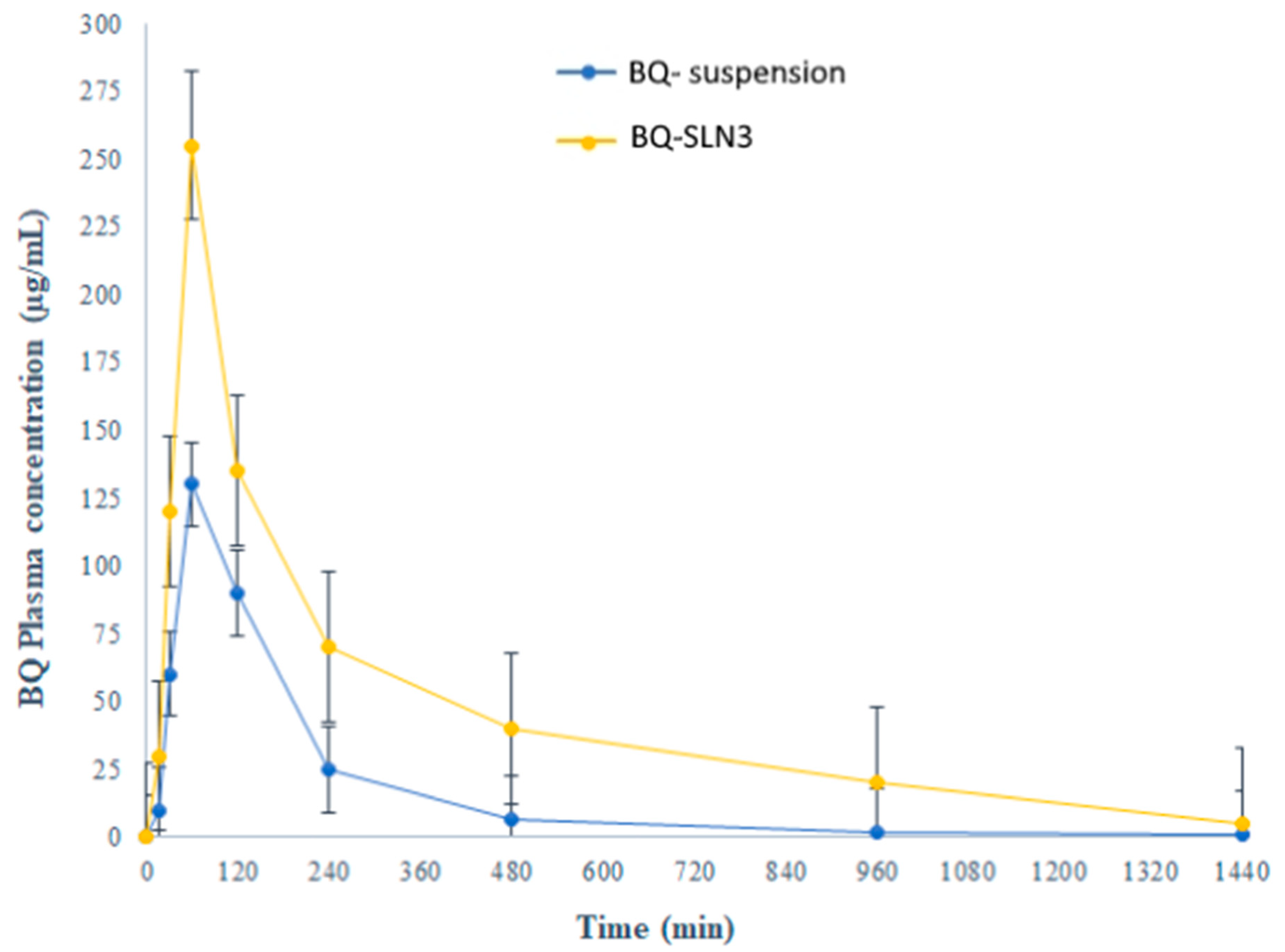
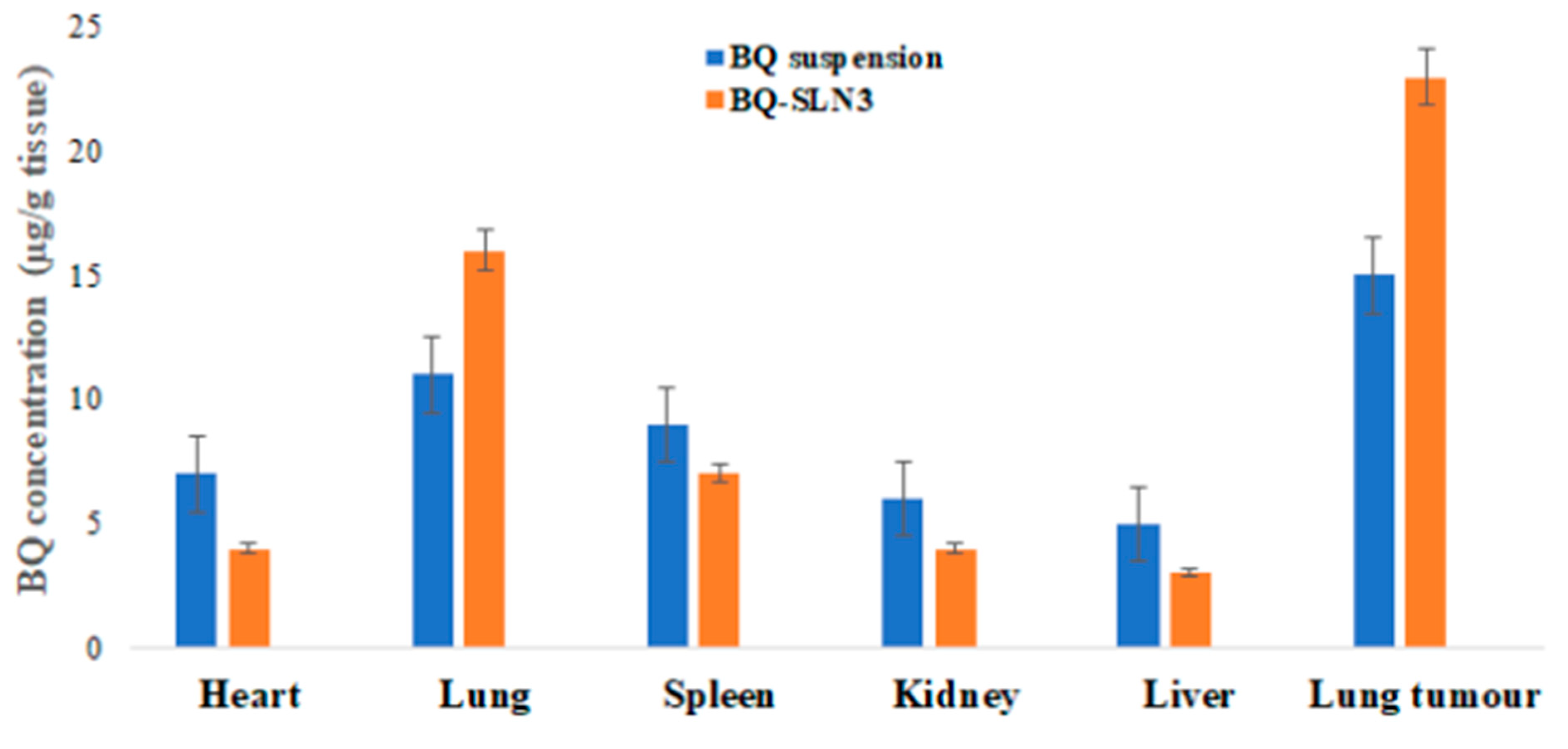
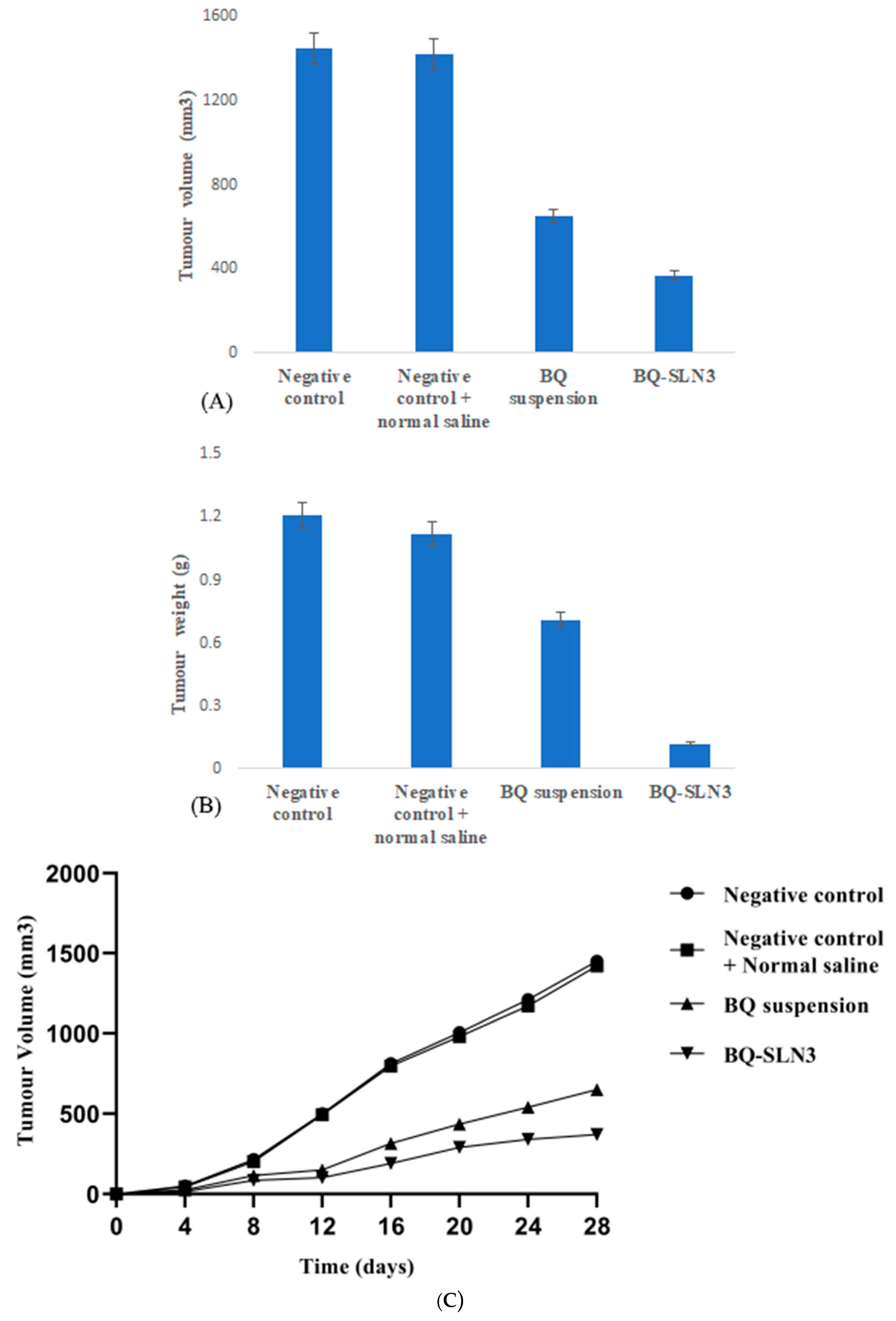
| Standard Conc. | Levels (%) | Predicted Conc. (ng mL−1) | Recovered Conc. (ng. ml−1) | Recovery (%) | RSD (%) |
|---|---|---|---|---|---|
| BQ (500 ng mL−1) | LQC: 50 | 100 | 101.0 ± 1.03 | 99.50 | 0.27 |
| MQC: 100 | 250 | 251.2 ± 1.37 | 99.82 | 0.26 | |
| HQC: 150 | 450 | 452.1 ± 1.08 | 99.98 | 1.25 |
| Standard Conc. (ng mL−1) | Recovered Conc. (ng mL−1) ± S.D. | Recovery (%) | RSD (%) |
|---|---|---|---|
| LQC: 100 | 99.2 ± 3.51 | 98.5 | 0.25 |
| MQC: 250 | 251.5 ± 2.2 | 99.6 | 0.32 |
| HQC: 450 | 451.1 ± 2.51 | 99.8 | 0.91 |
| Standard Conc. (ng mL−1) | Recovered Conc. (ng mL−1) ± S.D. | Recovery (%) | RSD (%) |
|---|---|---|---|
| LQC: 100 | 99.24 ± 3.12 | 98.70 | 0.41 |
| MQC: 250 | 249.31 ± 2.21 | 98.85 | 0.12 |
| HQC: 450 | 450.4 ± 2.07 | 99.91 | 1.31 |
| Solubilizers (Surfactant/Co-Surfactant) | Solubility (mg/mL) |
|---|---|
| Poloxamer 188 | 120 ± 4.11 |
| Tween 80 | 110 ± 5.31 |
| Poloxamer 407 | 85 ± 2.24 |
| Unitop100 | 70 ± 4.32 |
| Phospholipid 90 G | 90 ± 5. 41 |
| Soy lecithin | 76 ± 3.11 |
| Phospholipid 90 H (PL90H), | 80 ± 4.24 |
| Solubility of BQ in Lipids | |
| Capmul MCM C10 | 130 ± 6.02 |
| Compritol ATO 888 | 90 ± 5.25 |
| GMS | 75 ± 3.41 |
| Stearic Acid | 55± 3.21 |
| Formulation Code | Quantity of Solid Lipid (mg) | Quantity of PL90G (mg) | Quantity of Poloxamer 188 (mg) | Particle Size (nm) | PDI |
|---|---|---|---|---|---|
| BQ-SLN1 | 220 | 35 | 50 | 180 ± 12.65 | 0.421 ±0.05 |
| BQ-SLN2 | 260 | 70 | 140 | 195 ± 13.76 | 0.46 ± 0.04 |
| BQ-SLN3 | 350 | 55 | 100 | 144 ± 10.75 | 0.324 ± 0.03 |
| BQ-SLN4 | 300 | 45 | 120 | 175 ± 8.51 | 0.521 ± 0.06 |
| BQ-SLN5 | 400 | 65 | 75 | 210 ± 11.31 | 0.542 ± 0.02 |
|
Time (Day) |
Size (nm) | PDI | Zeta Potential (mV) | EE (%) | LC (%) |
|---|---|---|---|---|---|
| 0 | 144 ± 10.75 | 0.324 ± 0.03 | −16.3 ± 0.04 | 92.05 ± 6.12 | 13.33 ± 0.71 |
| 15 | 144.21 ± 8.05 | 0.326 ±0.04 | −16.28 ±0.05 | 92.03 ± 4.16 | 13.21 ± 0.61 |
| 30 | 144.35 ± 6.41 | 0.329 ±0.06 | −16.26 ± 0.07 | 92.0 ± 6.23 | 13.17 ± 0.43 |
| 60 | 144.42 ± 7.31 | 0.331 ±0.03 | −16.24 ± 0.06 | 91.98 ± 5.51 | 13.12 ± 0.32 |
| 90 | 144.53 ± 6.21 | 0.352 ± 0.04 | −16.01 ± 0.04 | 91.88 ± 5.23 | 13.05 ± 0.22 |
| Time (Day) | Size (nm) | PDI | Zeta Potential (mV) | EE (%) | LC (%) |
|---|---|---|---|---|---|
| 0 | 144 ± 10.75 | 0.324 ± 0.03 | −16.3 ± 0.04 | 92.05 ± 6.12 | 13.33 ± 0.71 |
| 15 | 146.41 ± 9.05 | 0.45 ± 0.04 | −14.12 ±0.05 | 90.03 ± 3.16 | 11.32 ± 0.52 |
| 30 | 149.21 ± 8.23 | 0.56 ± 0.07 | −12.34 ± 0.09 | 87.05 ± 5.11 | 10.22 ± 0.32 |
| 60 | 152.42 ± 10.31 | 0.62 ± 0.09 | −9.14 ± 0.06 | 84.98 ± 4.32 | 9.33 ± 0.31 |
| 90 | 158.23 ± 11.21 | 0.71 ± 0.10 | −7.05 ± 0.03 | 81.33 ± 4.11 | 8.91 ± 0.11 |
| Time (Day) | Size (nm) | PDI | Zeta Potential (mV) | EE (%) | LC (%) |
|---|---|---|---|---|---|
| 0 | 1180 ± 22.25 | 0.25 ± 0.04 | −0.0668 ± 0.02 | 88.89 ± 8.23 | 11.43 ± 0.65 |
| 15 | 1180.32 ± 20.12 | 0.27 ± 0.07 | −0.0660 ± 0.03 | 88.63 ± 7.23 | 11.23 ± 0.42 |
| 30 | 1180.75 ± 19.35 | 0.291 ± 0.08 | −0.0650 ± 0.04 | 88.43 ± 8.33 | 11.10 ± 0.32 |
| 60 | 1180.96 ± 21.35 | 0.299 ± 0.05 | −0.0630 ± 0.03 | 88.23 ± 7.33 | 10.97 ± 0.22 |
| 90 | 1181.23 ± 20.26 | 0.312 ± 0.05 | −0.0610 ± 0.04 | 87.89 ± 8.24 | 10.66 ± 0.35 |
| Time (Day) | Size (nm) | PDI | Zeta Potential (mV) | EE (%) | LC (%) |
|---|---|---|---|---|---|
| 0 | 1180 ± 22.25 | 0.25 ± 0.04 | −0.0668 ± 0.02 | 88.89 ± 8.23 | 11.43 ± 0.65 |
| 15 | 1180.8 ± 18.23 | 0.28 ± 0.03 | −0.0662 ± 0.03 | 88.65 ± 7.34 | 11.22 ± 0.45 |
| 30 | 1181.21 ± 19.33 | 0.32 ± 0.09 | −0.0655 ± 0.06 | 88.12 ± 6.22 | 10.43 ± 0.41 |
| 60 | 1182.22 ± 20.23 | 0.36 ± 0.07 | −0.0646 ± 0.07 | 87.67 ± 7.34 | 9.92 ± 0.23 |
| 90 | 1182.76 ± 19.45 | 0.41 ± 0.06 | −0.0640 ± 0.05 | 87.12 ± 6.22 | 9.50 ± 0.33 |
| Stability Parameters | SGF (pH 1.2) | SIF (pH 6.8) | ||
|---|---|---|---|---|
| Before | After | Before | After | |
| Particle size (nm) | 144 ± 10.75 | 144.21 ± 8.31 | 144 ± 10.75 | 144. 45 ± 8.45 |
| PDI | 0.324 ± 0.03 | 0.326 ± 0.05 | 0.324 ± 0.03 | 0.326 ± 0.05 |
| Zeta potential (mV) | −16.3 ± 0.07 | 16.21 ± 0.03 | −16.3 ± 0.07 | −16.15 ± 0.04 |
| Entrapment Efficiency (%) | 92.05 ± 6.12 | 92.01 ± 5.42 | 92.05 ± 6.12 | 92.02 ± 4.21 |
| Loading Capacity | 13.33 ± 0.71 | 13.22 ± 0.65 | 13.33 ± 0.71 | 13.11 ± 0.42 |
| Stability Parameters | SGF (pH 1.2) | SIF (pH 6.8) | ||
|---|---|---|---|---|
| Before | After | Before | After | |
| Particle size (nm) | 1180 ± 22.25 nm | 1180.21± 21.34 | 1180 ± 22.25 nm | 1180.73 ± 20.23 nm |
| PDI | 0.25 ± 0.04 | 0.27 ± 0.05 | 0.25 ± 0.04 | 0.29 ± 0.07 |
| Zeta potential (mV) | −0.0668 ± 0.02 | −0.0666 ± 0.07 | −0.0668 ± 0.02 | −0.0664 ± 0.02 |
| Entrapment Efficiency (%) | 88.89 ± 8.23 | 88.75 ± 7.45 | 88.89 ± 8.23 | 88.43 ± 5.21 |
| Loading Capacity | 11.43 ± 0.65 | 11.40 ± 0.41 | 11.43 ± 0.65 | 11.28 ± 0.67 |
| Formulations | Pharmacokinetics Parameters | |||||
|---|---|---|---|---|---|---|
| BQ suspension | Cmax (µg/mL) | Tmax (µg/mL) | AUC (µg/mL/h) | MRT (h) | Ka (h−1) | T 0.5 (h−1) |
| 130 ± 3.12 | 1.0 ± 0.30 | 1128.5 ± 12.12 | 14.23 ± 0.35 | 5.04 ± 0.27 | 9.61 ± 0.25 | |
| BQ-SLN3 | 255 ± 6.13 * | 1.0 ± 0.22 ** | 4412.4 ± 10.31 * | 6.22 ± 1.01 * | 2.8 ± 0.25 * | 3.71 ± 0.31 * |
| Biochemical Parameters | Normal Control Group of Rats (I) | Lung Cancer Group of Rats (II) | Treated Group of Rats with BQ-Suspension (III) | Treated Group of Rats by BQ-SLN3 (IV) |
|---|---|---|---|---|
| MDA (nmol/mg) | 50.55 ±3.87 | 80.21± 6.21 * | 66.01 ± 3.51 ** | 54.2 ± 0.32 *** |
| SOD (unit/mg) | 10.12 ± 0.81 | 4.21 ± 0.51 * | 7.21 ± 0.31 ** | 9.5 ± 0.61 *** |
| CAT (nmol/min/mg) | 905.12 ± 13.61 | 540 ± 9.12 * | 752.1 ± 9.22 ** | 881.2 ± 6.21 *** |
| GSH (μg/mg) | 4.51 ± 0.071 | 2.12 ± 0.12 * | 3.51 ± 0.21 ** | 4.22± 0.32 *** |
| GR nmol/min/mg | 5.21 ± 0.21 | 2.54 ± 0.22 * | 3.82 ± 0.22 ** | 4.99 ±0.31 *** |
Disclaimer/Publisher’s Note: The statements, opinions and data contained in all publications are solely those of the individual author(s) and contributor(s) and not of MDPI and/or the editor(s). MDPI and/or the editor(s) disclaim responsibility for any injury to people or property resulting from any ideas, methods, instructions or products referred to in the content. |
© 2023 by the authors. Licensee MDPI, Basel, Switzerland. This article is an open access article distributed under the terms and conditions of the Creative Commons Attribution (CC BY) license (https://creativecommons.org/licenses/by/4.0/).
Share and Cite
Najib Ullah, S.N.M.; Afzal, O.; Altamimi, A.S.A.; Alossaimi, M.A.; Almalki, W.H.; Alzahrani, A.; Barkat, M.A.; Almeleebia, T.M.; Alshareef, H.; Shorog, E.M.; et al. Bedaquiline-Loaded Solid Lipid Nanoparticles Drug Delivery in the Management of Non-Small-Cell Lung Cancer (NSCLC). Pharmaceuticals 2023, 16, 1309. https://doi.org/10.3390/ph16091309
Najib Ullah SNM, Afzal O, Altamimi ASA, Alossaimi MA, Almalki WH, Alzahrani A, Barkat MA, Almeleebia TM, Alshareef H, Shorog EM, et al. Bedaquiline-Loaded Solid Lipid Nanoparticles Drug Delivery in the Management of Non-Small-Cell Lung Cancer (NSCLC). Pharmaceuticals. 2023; 16(9):1309. https://doi.org/10.3390/ph16091309
Chicago/Turabian StyleNajib Ullah, Shehla Nasar Mir, Obaid Afzal, Abdulmalik Saleh Alfawaz Altamimi, Manal A. Alossaimi, Waleed H Almalki, Abdulaziz Alzahrani, Md. Abul Barkat, Tahani M. Almeleebia, Hanan Alshareef, Eman M. Shorog, and et al. 2023. "Bedaquiline-Loaded Solid Lipid Nanoparticles Drug Delivery in the Management of Non-Small-Cell Lung Cancer (NSCLC)" Pharmaceuticals 16, no. 9: 1309. https://doi.org/10.3390/ph16091309
APA StyleNajib Ullah, S. N. M., Afzal, O., Altamimi, A. S. A., Alossaimi, M. A., Almalki, W. H., Alzahrani, A., Barkat, M. A., Almeleebia, T. M., Alshareef, H., Shorog, E. M., Khan, G., Singh, T., & Singh, J. K. (2023). Bedaquiline-Loaded Solid Lipid Nanoparticles Drug Delivery in the Management of Non-Small-Cell Lung Cancer (NSCLC). Pharmaceuticals, 16(9), 1309. https://doi.org/10.3390/ph16091309








